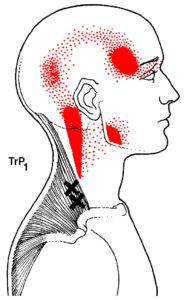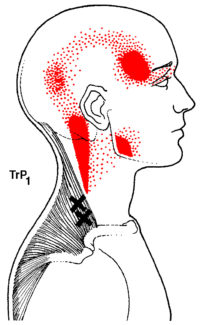
After sitting poorly at a computer from a long day at work, it is common to feel some neck tension and possibly experience a few headaches. One of the most common muscles causing this pain is your trapezius. Stress or hormonal issues might feel like the cause, but they are commonly switches that turn on the already existing trapezius trigger points, thus turning on that pain pattern and discomfort.
The Much Massaged Trapezius
Your trapezius muscle attaches from the bottom of your skull, out to your shoulders, down your mid spine, and along the spine in between those areas. It forms a trapezoid, hence the smart anatomical name. The upper trapezius is a prime culprit in many headaches (see pic 1), and the lower trapezius trigger points refer pain into the neck/shoulder area where the upper trapezius attaches (see pic 2 below).
Putting pressure on these trigger points releases them and can greatly decrease pain and tension, if the red pain pattern is what you’re experiencing. However, until you correct the root of the issue (usually postural and/or neck weakness), the pain and headaches will continue to return.
Preventing These Nasty Trigger Points

So, not only is it helpful to work out the trigger points causing your pain in the neck, but accessing and massaging the front of the neck, to allow the head to float back into better alignment (and not be so protruded) prevents trigger points in the trapezius from forming again.
Because you have many nerves and arteries close to the surface at the front of your neck, it’s important to seek out a skilled massage therapist, and one who is familiar with postural work or myofascial techniques.
The other area that is widely overlooked regarding neck pain and headaches, is your shoulder (or glenohumoral) joint.
If your shoulder is sitting forward in its socket, chances are, your trapezius muscle is working hard to hold it back from gravity. Just like a forward head, this forward shoulder creates trigger points in your trapezius muscle, usually in the lower trapezius, which works counter to your pectoralis minor- that little, nagging muscle pulling your shoulder forward and down.
Again, it’s so important to lengthen the FRONT of the shoulder, and engage/strengthen the muscles that help pull your shoulder back and into its socket. Your massage therapist can help lengthen the front muscles and fascia of your shoulder, and you can do some exercises to strengthen and maintain that length…
My Favorite Videos On How To Engage Weak Shoulder Muscles
Wall Angel: Helps to Lengthen & Strengthen
Yoga Sequence for Neck & Shoulder Tension
The last 2 videos are made by a good friend and fellow structural bodyworker. I highly recommend her stack your bones apps for improved body alignment and coordination.
If you’re experiencing neck pain or headaches that don’t reflect the pain patterns discussed here, you likely have trigger points in another muscle acting on the head and neck. Feel free to post your issue or give us a call 801-878-6044 to visit one of our highly skilled Salt Lake City massage therapists.





Follow